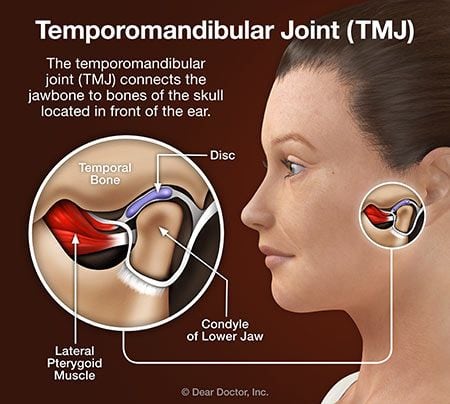
The temporomandibular joints (TMJ) connect the jawbone to bones of the skull located in front of the ear. These joints allow us to move our jaw up and down and from side to side so we can chew, talk, laugh and yawn. Problems that affect the jaw joints, muscles and other surrounding tissues are called temporomandibular joint disorders (TMJD or TMD). TMJ disorders are prevalent in approximately 5-12% of the population and are more common among women. While the cause of TMJD can be difficult to determine, the condition can result in pain and limited function in and around the jaw. Fortunately, many who suffer from this potentially debilitating condition have found relief through chiropractic care.
Symptoms and Risk Factors of TMJ Disorders
The most common symptoms of TMJD include pain or tenderness in the jaw joint area, as well as pain and tightness in the neck and shoulders. The pain can impact only one or both jaw joints. There may also be an aching pain in and around the ear, pain while chewing, and difficulty chewing. A person’s jaw may lock, which makes opening and closing the mouth difficult. Another common symptom of TMJD is a clicking sound or grating sensation when opening the mouth or chewing.
Factors contributing to the risk of developing TMJD include genetics, a jaw injury, rheumatoid arthritis, osteoarthritis, long-term grinding or clenching of the teeth and a disease of the connective tissues around the jaw joint.
Treatment for TMJ Disorders

Chiropractic care is helpful for alleviating some of the pain and additional symptoms associated with TMJD. Upon your first visit, a chiropractor will evaluate your symptoms and examine your jaw and neck. X-rays may be ordered to further investigate contributing factors.
Many chiropractors who treat TMJD focus on the cervical (neck) spine and the contribution of cervical dysfunction to TMJD. Chiropractic treatment for TMJD may involve adjustments to the neck or muscle work (generally targeting the pterygoid, a chewing muscle). Other treatment methods may include soft tissue massage, special exercises and intraoral myofascial release. In addition, we may suggest lifestyle changes to help improve your condition.
Why Seek Chiropractic Treatment for TMJD?
Chiropractors can help diagnose TMJD and recommend treatments based upon your unique condition—and if needed, we can refer you out to another health care practitioner. If you are experiencing symptoms of a TMJ disorder, it’s important to seek treatment as soon as possible. Not only can we diagnose TMJD and treat many of your symptoms, we can also help manage your treatment and recovery journey in a holistic, noninvasive way.
